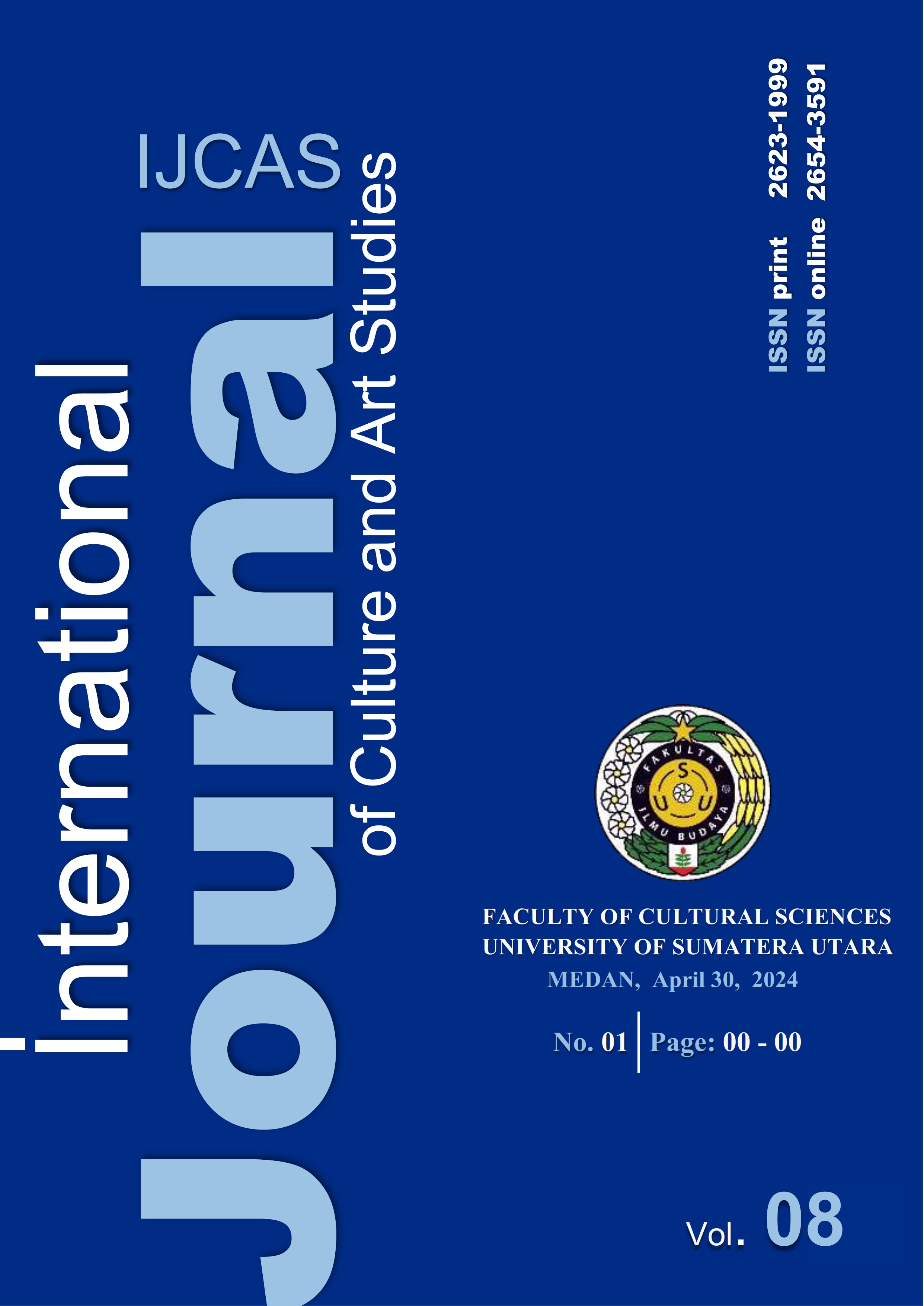Exploring Materials for Constructing Fancy Dress Masquerade Costumes in Winneba, Ghana (1958-2020)
DOI:
https://doi.org/10.32734/ijcas.v8i1.15858Keywords:
Costume, Costume Construction, Fancy Dress Masquerade, Materials, WinnebaAbstract
The representation of Fancy Dress masquerades in Ghana, particularly in Winneba, has been revered as part of the country’s popular culture. Fancy Dress masquerade performances, which originated in coastal towns of Ghana during the 18th century under the aegis of colonialism, are currently seen in popular parades and club competitions. Undoubtedly, the utilisation of costumes forms the cornerstone of Fancy Dress masquerading. Although Fancy Dress masquerade costumes add to the depth and breadth of the performance, little empirical study exists on the materials used to construct costumes for this performance. In this study, we explore materials used to construct Fancy Dress masquerade costumes in Winneba, Ghana, from 1958 to 2020. Using a qualitative approach, multiple instruments, and engaging thematic and document analytical frames to analyse the data, the findings of the study revealed the use of fabrics; leather and jute bags. The rest were foam; agricultural products; paper, strawboards and used packaging boxes; net, fibre and plastic sachets to construct costumes such as ‘cowboy’, ‘tigers’ and ‘hunters’. With a treasure trove of materials, fabrics were chiefly used due to their unique physical properties. On the heels of the finding, we recommend that practitioners explore non-conventional and sustainable materials to maintain ecological sustainability. Ultimately, the study advances the understanding of masquerade costumes by addressing gaps in the literature and providing new perspectives.
Downloads
References
Acquaye, R. (2018). Exploring indigenous West African fabric design in the context of contemporary global commercial production. (Doctoral thesis, University of Southampton). Retrieved from https://eprints.soton.ac.uk/429749/1/Final_PhD_Thesis_25751093.pdf
Agoro, S. N. A. (2010). The demise of the performance art of masquerade: A case study of the phenomenon in Igbogene State. Kamla 8(1), 13-19.
Akubor, E. O. (2016). Africans concept of masquerades and their role in societal control and stability: Some notes on the Esan people of southern Nigeria. Asian and African Studies, 25(1). 32-50.
Akyeampong, O.A., & Yankholmes, A. (2016). Profiling masquerade festival attendees in Ghana. Event Management, 20. 285–296.
Amaechi, L. (2018). The use of masquerade cult and Umu-Ada fraternity (Igbo daughters) for peace and conflict resolution in Eastern Nigeria (Igbo land). American International Journal of Social Science, 7(2), 83-91.
Anderson, S. (2018). Letting the mask slip: The shameless fame of Sierra Leone's Gongoli. Africa, 88(4), 718-743. doi:10.1017/S000197201800044X
Asigbo, A. C. (2010). Transmutations in masquerade costumes and performances: An examination of Abuja carnival 2010. Journal of Arts and Humanities, 13 (1) .1-13.
Barton, L. (1963). Historic costumes for the stage. Boston: Walter H. Baker Company.
Bowen, G. A. (2009). Document analysis as a qualitative research method. Qualitative Research Journal, 9 (2), 27-40.
Crist, B. (2014). The art of costuming: Interpreting the character through the costume designer’s eyes. (Master’s thesis, Liberty University). Retrieved from https://digitalcommons.liberty.edu/cgi/viewcontent.cgi?article=1469&context=honors.
Callender, A. (2017). Folk culture and costume at the folk museum in Barbados. Retrieved from http://www.clothestellstories.com/index.php/telling- stories- with-clothes/folk-culture-and-costumes-at-the-folk-museum- barbados.
Duerden, D. (2000). The discovery of the African mask. Research in African Literatures, 31(4), 29-47.
Emiemokumo, A. A .N. (2012). Visual art form in motion: Traditional African masquerade as theatrical phenomenon. Mgbakoigba: Journal of African Studies, 1, 1-8.
Enendu, M. (2004). The nature of the African masquerade in performance. Sankofa Journal of the Humanities, 2(1), 47-68.
Flock, T.S. (2017). Disguise: Masks and global African art. African Arts, 50 (3), 85-86.
Furniss, G. J. (2015). Viewing sub-saharan African art with Western eyes: A question of aesthetics in the context of another culture and time. Art Education, 68 (6), 28-35.
Gavor, M., & Dennis, A. (2013). Evolution and use of patchwork fabric (nsasawa) in Ghana. The Parnassus: University of Uyo Journal of Cultural Research, 9(2), 225-237.
Ganyi, F. M., Inyabri, I. T., & Okpiliya, J. O. (2013). Performance aesthetics and functionalism: The legacy of Atam masquerade of the Bakor people of Ogoja local government area. International Journal of Humanities and Social Invention, 2(10), 50-62.
Gillette, M. J. (2000) Theatrical design and production: An introduction to scene design and construction, lighting, sound, costume, and makeup. (4th ed). New York: McGraw Hill.
Hooks, B. L. (1990). The Crisis. 97 (10), 7-8.
Johnson, E. (2004). Aesthetics: The dialectics and theatrics of theatre and communication. Lagos: Concept Publications.
Kwakye-Opong, R., & Adinku, G. U. (2013). Costume as medium for cultural expression in stage performance. Arts and Design Studies, 8, 9-18.
Ingham, R. & Covey, L. (1992). The costume designer’s handbook: A complete guide for amateur and professional costume designers. (2nd ed.). England Cliffs, New Jersey: Prentice – Hall, Inc.
Micots, C. (2014). Carnival in Ghana: Fancy Dress street parades and competition. African Arts, 47 (1), 30-41.
Mamiya, W. A. S. (2016). Costume aesthetics: Found objects as dressing in the production of the slaves. (Master’s thesis, University of Ghana) Retrivedfromhttp://ugspace.ug.edu.gh/bitstream/handle/123456789/2346/Costume%20Aesthetics%20Found%20Objects%20as%20Dressing%20in%20the%20Production%20of%20the%20Slaves.pdf?sequence&isAllowed=y
Micah, V.K.B. (2014). Beliefs and practices associated with masquerading culture in winneba, Ghana. Unpublished doctoral thesis, Department of Music Education, University of Education, Winneba.
Negi, M., Rani, A., & Singh, A. (2015). New horizon for Aipan (folk art of uttarakhand): Motifs through appliqué. International Journal of Research-Granthaalayah. 3(9). 36-48.
Nicholls, R.W. (2009). Running John Bull: The provenance of a masquerader in the Lesser Antilles. Folklore 120(2). 133-156.
Nicholls, R.W. (2012). The jumbies’ playing ground: Old world influences on afro-creole masquerades in the eastern Caribbean. Jackson: University of Mississippi.
Nunley, J. (2010). Jolly masquerades of Sierra Leone and the Creole histories of Atlantic Rim performance arts. In A. Apter & L. Derbry (Eds.), Activating the past: History and memory in the black Atlantic world. New Castle, Tyne: Cambridge scholars publishing.
Ottenberg, S. (1982). Illusion, communication, and psychology in West African masquerades. Ethos, 10(2), 149-185.
Ododo S. E. (2001). Theatrical aesthetics and functional values of ekuechi masquerade ensemble of the Ebira people in Nigeria. African Study Monographs, 22(1), 1-36.
Peek, P.M., & Yankah, K. (2004). African folklore: An Encyclopedia. New York: Routledge.
Regis, H.A. (Ed.). (2006). Caribbean and southern transnational perspectives on the U.S. south. Athens: The University of Georgia Press.
Strand-Evans, K. (2015). Costume construction. (2nd ed.). Long Grove, Illinois; Waveland Press, Inc.
Sarpong, A. and Botchway, D.N.Y.M. (2019). Adults are just children …? Child fancy dress parades as a carnivalesquue suspension of adultism in Winneba, Ghana. In Botchway, D.N.Y.M., Sarpong, A. & Quist –Adade, C. (Eds.) New perspectives on African Childhood: constructions, histories, representations and Understandings (pp.171-195). Wilmington: Vernon Press.
Sarpong, A. and Botchway, D.N.Y.M. (2017). Freaks in performance? The Fancy Dress masquerade as heaven for negotiating eccentricity during childhood. In Bohlmann, M.P.J. (Ed.) Misfit children: An inquiry into childhood belongings (pp. 176-196) Lanham, Maryland: Lexington Books.
Tojo, N. (2012). Prevention of textile waste: Material flows of textiles in three nordic countries and suggestions on policy instruments. Nordic council of ministers.
Wilcox, R. (1958). The mood in costume. New York: Charles Scribner's Sons.
Downloads
Published
How to Cite
Issue
Section
License
Copyright (c) 2024 Albert Dennis, Fabiola Mamle Opare Darko

This work is licensed under a Creative Commons Attribution-ShareAlike 4.0 International License.













